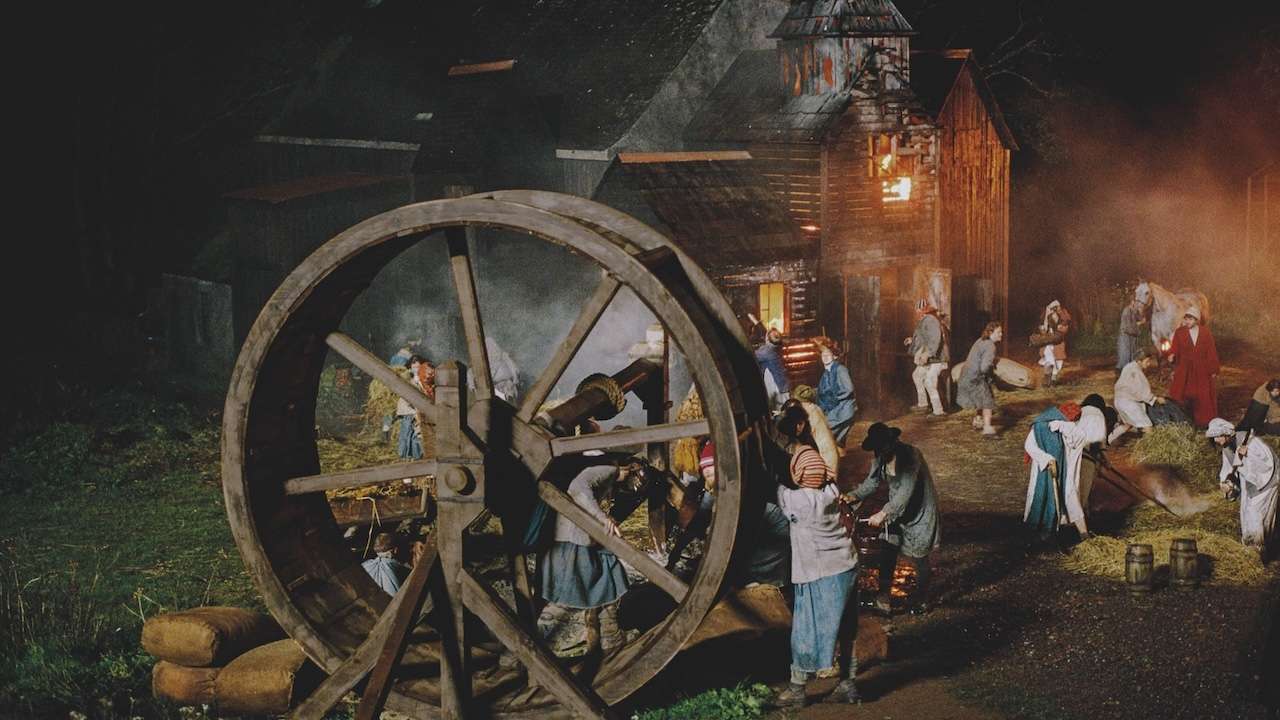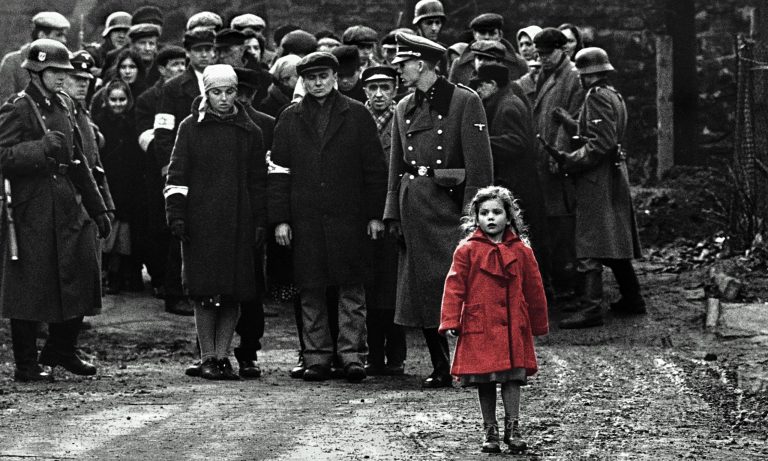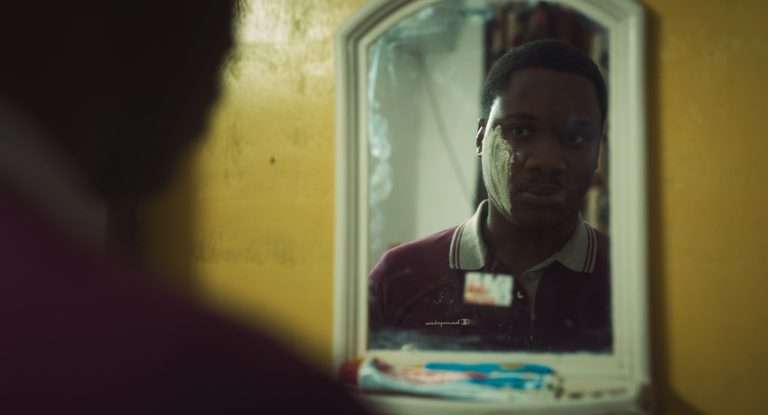The folk-horror genre has been a perennial mainstay on screens for decades, with recent installments from films like Midsommar, Enys Men, and more recently Starve Acre revitalizing the genre. Harvest, which marks the English-language debut of Greek director Athina Rachel Tsangari, continues this tradition but deploys it in more novel ways. The film utilizes its quasi-folk-horror sensibility to paint an elegiac portrait of a pre-industrial village in the Scottish Highlands.
The film, adapted from Jim Crace’s novel of the same name, follows a small community nearing the end of the harvest season, run under their master Charles Kent (Harry Melling), who inherited the estate their village is on from his late wife, and his right-hand man Walter Thirsk (Caleb Landry Jones). The village displays all the traditional trappings of folk-horror communities found in films like The Wicker Man. They consciously live outside the gaze of God, engage in bizarre practices, like banging children’s heads against rocks, and carry out pagan dances around a bonfire in elaborate animal masks. There is even a lot of wicker.

They are also highly wary of outsiders and those they believe don’t belong. This includes a mapmaker called Quill (Arinze Kene), whom Kent has hired to chart his land, and a trio of two men and a woman who they falsely accuse of burning down their barn. The village is forced to belligerently accept Quill’s presence but punishes the others for their supposed crimes. The two men are locked in pillories while the villagers shave the woman’s head and accuse her of witchcraft before she flees and begins stalking them in the dead of night. The film continually plays with the horror genre in this way, maintaining a creeping sense of dread throughout its runtime. However, it never dives headlong into all-out horror and opts to teeter on the edge of the sinister and the supernatural. Instead, Tsangari fixes the film closer to the ground to forge an earthly and elemental picture of pre-industrialized agricultural life.
The film is at its strongest when focusing on its profound sense of place and powerful evocation of what life is like living in the Scottish Highlands. Tsangari lingers deliberately on the toil of the village community, and the film’s early pacing embeds us in the rhythms of their daily labors. There are hypnotic scenes of villagers reaping wheat fields and foraging through the squelchy mud. There are bracing winds, torrential downpours, and limbs bloodied and beaten from work. We are taken literally and figuratively into the mud to show the squishy and physical reality of farming life, all of which is filtered through the laden yet gorgeous lens of cinematographer Sean Price Williams.
Harvest is a film so tactile and so textured you can practically feel it through the screen, and indeed the frame itself flickers and lightly disintegrates around the edges, as though infused with the Highlands’ earthy detritus and fiery sunsets. Even human bodies are melded into nature as demonstrated by a wordless opening sequence where Thirsk is shown munching on bark, licking the inside of trees, and then bathing in a loch with his body caressed by the ripples of water around him. Tsangari roots her characters physically and primally in their surrounding landscape and deftly captures the beauty, brutality, and fragility of their relationship with the local ecosystem. The villagers are born from this earth, they breathe this earth, and so they believe they belong on this earth.
However, their delicate and insular world is then challenged by yet more outsiders with the arrival of Henry’s cousin-in-law Jordan (Frank Dillane) and his slew of well-groomed advisers. Jordan intends to use the maps commissioned from Quill to uproot and restructure the land into a sheep farm to produce wool for his factory. He quickly takes charge of the estate, rendering Kent a mute bystander, and sets about implementing new draconian policies of work and punishment. Much like its villagers, the film seems unsure about how to deal with these developments as it wrestles to fit its wandering and lilting narrative into a more conventional structure. It develops into a more straightforward story of peasant workers pitted against their greedy lord, which feels at times thematically perfunctory and narratively unsatisfying. This is best epitomized in the character of Jordan himself, who is a moustache-twirling villain who sneers at local customs. He bluntly embodies the social ills of expansionist industrial capitalism with his plan to convert a “village of enough” into a “settlement of plenty.” He even bemoans the existence of trees which produce nothing of value apart from shade.
Also, Read – First Feature Competition at the 68th BFI London Film Festival (2024)
The film finds more fertile soil when it reflects on humanity’s lost connection with nature in a modernizing world. Thirsk criticizes Quill’s maps for how they have “flattened us” and created a detached and distorted view of what their land is like. He tells Quill, “Your land is easy. It’s a lie” as it contains no intimate knowledge and therefore no truth. It is a poignant lamentation on the flattening effects of capitalism and modernization and how it disconnects us from our natural existence.
However, Harvest thrives best when it stays firmly within the natural world and is allowed to ramble and meander and bask in the bitter beauty of the world it creates. It is a world that feels both alienating and alluring, both uncanny and inviting. It is a world that has disappeared from reality, but here is conjured up so tangibly as to feel brought to life once more.


![Shin Ultraman [2022]: ‘NYAFF’ Review – More like an episodic love letter to Ultraman by fans than a cohesive movie](https://79468c92.delivery.rocketcdn.me/wp-content/uploads/2022/07/SHIN-ULTRAMAN-MOVIE-REVIEW-3-768x512.jpg)




![The Crossing [2019]: ‘NYAFF’ Review – The Queen of Hong Kong](https://79468c92.delivery.rocketcdn.me/wp-content/uploads/2019/07/The-Crossing-highonfilms-768x512.jpg)